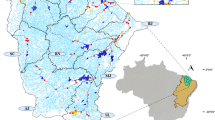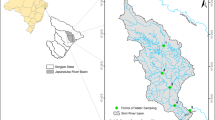Abstract
Seasonal spatial and temporal changes of selected eco-chemical parameters in section of the Danube River flowing through Serbia were analyzed. Data for electrical conductivity (EC), dry and suspended matter, residue on ignition, chemical oxygen demand (COD), biochemical oxygen demand (BOD-5), ultraviolet extinction, dissolved oxygen (DO), oxygen saturation, pH, nitrates, total phosphorus, and nitrogen were collected between 1992 and 2006. The use of monthly medians combined with linear regression and two-sided t test has been proven to be the best approach for resolving trends from natural variability of investigated parameters and for determining trend significance. Patterns of temporal changes between different months were examined. It was also determined that spatial trends of some parameters oscillate in predictable manner, increasing in one part of the year and declining in the other. Regression slope coefficients, an excellent indicator for determining when the water quality is changing the most along the course of the Danube, reach their maximum during summer for temperature (t), electric conductivity, nitrates, and total N, while in the same season suspended matter, COD, BOD-5, DO, and oxygen saturation coefficients reach their minimum. Correlations for used data sets of selected parameters were analyzed for better understanding of their behavior and mutual relations. It was observed that as Danube flows through Serbia, its general eco-chemical status either stagnates or improves, but the rate of river self-purification often depends on the season of the year.
Similar content being viewed by others
References
13.060.30 JUS H.Z1. 160 (1987). Testing of industrial waters—Determination of suspended matters—Gravimetric method.
APHA AWWA WEF (1992a). 4500-NO \(_{3}^{-}\) NITROGEN (NITRATE).
APHA AWWA WEF (1992b). 4500-P PHOSPHORUS.
APHA AWWA WEF (1992c). Standard methods for the examination of water and wastwater 18th Edition.
Avis, C. H., & Weller, P. H. (2000). The water framework directive and the Danube River basin: Opportunities enhanced ecological management and public participation. European Water Management, 3(2), 46–50.
Behrendt, H., van Gils, J., Schreiber, H., & Zessner, M. (2005). Point and diffuse nutrient emissions and loads in the transboundary Danube River Basin.—II. Long-term changes. Archiv fuer Hydrobiologie, Supplement, 158(1–2), 221–247.
Crnković, D., Crnković, N., Filipović, A., Rajaković, Lj., Perić-Grujić, A. Jr., & Ristić, M. (2008). Danube and Sava river sediment monitoring in Belgrade and its surroundings. Journal of Environmental Science and Health, Part A: Toxic/Hazardous Substances & Environmental Engineering, 43(12), 1353–1360.
Dumbrava, A., & Birghila, S. (2009). Analysis of some metal levels in Danube River water. Environmental Engineering and Management Journal, 8(2), 219–224.
Dumbrava, A., Birghila, S., & Enache, I. (2008). Water quality characteristics along the course of the Danube River. III The Cernavoda area. Analele Universitatii “Ovidius” Constanta, 19(1–2), 19–26.
Enache, I. (2008). The second joint Danube survey expedition—Hazardous metals and metals concentration from Danube river sediment. Analele Universitatii Bucuresti, Chimie, 17(2), 61–69.
EPA 360.2. (1971). Oxygen, Dissolved (Modified Winkler, Full-Bottle Technique).
Galatchi, L. D., & Vladimir, A. N. (2006). Critical analysis of the Danube River water quality in Tulcea (Romania) as part of the sustainable development evaluation of the region. Analele Universitatii “Ovidius” Constanta, Seria: Chimie, 17(2), 242–247.
Guieu, C., & Martin, J. M. (2002). The level and fate of metals in the Danube River plume. Estuarine, Coastal and Shelf Science, 54(3), 501–512.
ICPDR (2005). Danube Basin Analysis (WFD Roof Report 2004) ICPDR Document IC/084.
ISO 5667-6 (1990). Water quality—Sampling—Part 6: Guidance on sampling of rivers and streams.
JUS ISO 5663 (1984). Water quality—Determination of Kjeldahl nitrogen.
JUS ISO 8467 (1986). Water quality—Determination of permanganate index.
Kalchev, R., Ionica, D., Beshkova, M., Botev, I., & Sandu, C. (2008). Long-term and seasonal changes of nutrients, seston and phytoplankton concentrations in the Lower Danube (Bulgarian-Romanian stretch). Archiv fuer Hydrobiologie, Supplement, 166(1–2), 25–43.
Kanji, G. K. (2006). 100 Statistical Tests, (3rd Edn). London: SAGE Publications Ltd.
Kenarova, A. (2005). Participation of microorganisms in self-purification processes of Maritsa river in its upper flow, Bulgaria. Journal of Balkan Ecology, 8(3), 317–325.
Kraus-Miljević, N. (1985). Supersaturation of dissolved oxygen in the river Velika Morava. Journal of the Serbian Chemical Society, 50(8), 413–418.
Krmar, M., Slivka, J., Varga, E., Bikit, I., & Vesković, M. (2009). Correlations of natural radionuclides in sediments from the Danube River. Journal of Geochemical Exploration, 100(1), 20–24.
Küchler, I. L., Miekeley, N., & Forsberg, B. R. (2000). A contribution to the chemical characterization of rivers in the Rio Negro Basin, Brazil. Journal of the Brazilian Chemical Society, 11(3), 286–292.
Kundev, V., Dombalov, I., & Pelovski, Y. (2001). Transboundary “hot spots” between Bulgaria, Romania and Yugoslavia. Journal of Environmental Protection and Ecology, 2(3), 589–594.
Lair, G. J., Zehetner, F., Khan, Z. H., & Gerzabek, M. H. (2009). Phosphorus sorption–desorption in alluvial soils of a young weathering sequence at the Danube River. Geoderma, 149(1–2), 39–44.
Laurencelle, L., & Dupuis, F. A. (2002). Statistical Tables, Explained and Applied. Singapore: World Scientific Publishing Co. Pte. Ltd.
Literathy, P. (2006). Monitoring and assessment of oil pollution in the Danube River during the transnational joint Danube survey. Water Science and Technology, 53(10), 121–129.
Liu, Z., Liu, X., & Liao, C. (2008). Daytime deposition and nighttime dissolution of calcium carbonate controlled by submerged plants in a karst spring-fed pool: Insights from high time-resolution monitoring of physico-chemistry of water. Environmental Geology, 55, 1159–1168.
Madarasz, C., & Horvath, L. (2001). Analysis of the salt component parameters in the Danube, 1977–1996. North-Transdanubian Authority for Environmental Protection, Hung, Verhandlungen-Internationale Vereinigung fuer Theoretische und Angewandte Limnologie, 27(7), 3954–3958.
Meier, P. C., & Zund, R. E. (2000) Statistical Methods in Analytical Chemistry (2nd Edn). New York: Wiley.
Milenković, N., Damjanović, M., & Ristić, M. (2005). Study of heavy metal pollution in sediments from the Iron Gate (Danube river), Serbia and Montenegro. Polish Journal of Environmental Studies, 14(6), 781–787.
Miljević, N., Golobočanin, D., Ogrinc, N., & Bondzić, A. (2008). Distribution of stable isotopes in surface water along the Danube River in Serbia. Isotopes in Environmental and Health Studies, 44(2), 137–148.
Miller, J. N., & Miller, J. C. (2005). Statistics and Chemometrics for Analytical Chemistry (5th Edn). Harlow: Pearson Education Limited.
Oresčanin, V., Lulić, S., Medunić, G., & Mikelić, L. (2005). Granulometric and chemical composition of the Danube River sediments, Batina village, Croatia. Geologia Croatica, 58(2), 185–194.
Pajević, S., Borišev, M., Rončević, S., Vukov, D., & Igić, R. (2008). Heavy metal accumulation of Danube river aquatic plants—Indication of chemical contamination. Central European Journal of Biology, 3(3), 285–294.
Park, J. H., Mitchell, M., & Driscoll, C. (2005). Winter-time climatic control on dissolved organic carbon export and surface water chemistry in an adirondack forested watershed. Environmental Science and Technology, 39, 6993–6998.
Pawellek, F., Frauenstein, F., & Veizer, J. (2002). Hydrochemistry and isotope geochemistry of the upper Danube River. Geochimica et Cosmochimica Acta, 66(21), 3839–3853.
Polić, P., Grzetić, I., & Jovancicević, B. (1994). Oxygen saturation variability in River Timok (Serbia/Bulgaria). Fresenius Environmental Bulletin, 3(7), 433–438.
Prathumratana, L., Sthiannopkao, S., & Kim, K. W. (2008). The relationship of climatic and hydrological parameters to surface water quality in the lower Mekong River. Environment International, 34, 860–866.
Relić, D., Đorđević, D., Popović, A., Jadranin, M., & Polić, P. (2010). Fractionation and potential mobility of trace metals in Danube alluvial aquifer within an industrialized zone. Environmental Monitoring and Assessment, 171(1–4), 229–248.
RHMZ (2009). 30 year averages http://www.hidmet.sr.gov.yu/latin/meteorologija/klimatologija_srednjaci.php. Accessed 28 December 2009.
Schreiber, H., Behrendt, H., Constantinescu, L. Th., Cvitanic, I., Drumea, D., Jabucar, D., et al. (2005). Point and diffuse nutrient emissions and loads in the transboundary Danube River Basin.—I. A modelling approach. Archiv fuer Hydrobiologie, Supplement, 158(1–2), 197–220.
Teodoru, C., & Wehrli, B. (2005). Retention of sediments and nutrients in the Iron Gate I reservoir on the Danube River. Biogeochemistry, 76(3), 539–565.
US EPA (1983). Methods for Chemical Analysis of Water and Wastes EPA/600/4-79/020.
Vadadi-Fülöp, C., Hufnagel, L., & Zsuga, K. (2010). Effect of sampling effort and sampling frequency on the composition of the planktonic crustacean assemblage: A case study of the river Danube. Environmental Monitoring and Assessment, 163(1–4), 125–138.
van Gils, J., Behrendt, H., Constantinescu, A., Laszlo, F., & Popescu, L. (2005). Changes of the nutrient loads of the Danube since the late eighties: An analysis based on long term changes along the whole Danube River and its main tributaries. Water Science and Technology, 51(11), 205–212.
Veljković, N. (2005). Global Wastewater Study and Sustainable Development Strategy for Serbia in Modern Technical Procedures in Sewage, Belgrade, Serbia, (2005).
Vogel, B. (2003). Joint Danube Survey. Investigations on the quality of the river Danube from its upper section to its delta. Oesterreichische Wasser- und Abfallwirtschaft, 55(9–10), 155–165.
Vukov, D., Pal, B., Igić, R., & Anačkov, G. (2008). The distribution and the abundance of hydrophytes along the Danube River in Serbia. Central European Journal of Biology, 3(2), 177–187.
Vuković, Z., Sipka, V., Vuković, D., Todorović, D., & Marković, L. (2006). Behavior of long-lived radionuclides in the Danube River ecosystem. Journal of Radioanalytical and Nuclear Chemistry, 268(3), 647–649.
Winter, C., Hein, T., Kavka, G., Mach, R., & Farnleitner, H. (2007). Longitudinal changes in the bacterial community composition of the Danube River: A whole-river approach. Applied and Environmental Microbiology, 73(2), 421–431.
Živadinović, I., Ilijević, K., Gržetić, I., & Popović, A. (2010). Long term changes of the Danube River ecochemical status in the region of Serbia. Journal of Serbian Chemical Society, 75(8), 1125–1148.
Author information
Authors and Affiliations
Corresponding author
Rights and permissions
About this article
Cite this article
Ilijević, K., Gržetić, I., Živadinović, I. et al. Long-term seasonal changes of the Danube River eco-chemical status in the region of Serbia. Environ Monit Assess 184, 2805–2828 (2012). https://doi.org/10.1007/s10661-011-2153-0
Received:
Accepted:
Published:
Issue Date:
DOI: https://doi.org/10.1007/s10661-011-2153-0




